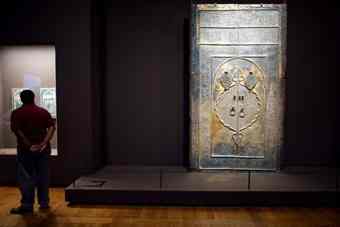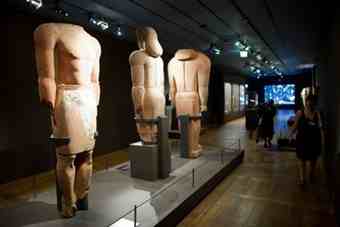For the first time, the ancient past of Saudi Arabia is at the heart of an exhibition at the Louvre museum in Paris, which is showing works that have never left their country before.
 The exhibition, which opens on Wednesday, comprises works that "have never been seen not just in the West, but for the most part not in Saudi Arabia," Beatrice Andre-Salvani, director of the department of Near Eastern Antiquities at the Louvre, told AFP.
The exhibition, which opens on Wednesday, comprises works that "have never been seen not just in the West, but for the most part not in Saudi Arabia," Beatrice Andre-Salvani, director of the department of Near Eastern Antiquities at the Louvre, told AFP.
The show is the outcome of a 2004 accord between the Louvre and the Saudi commission for tourism and antiquities. It will present around 320 pieces, of which two-thirds predate the birth of Islam in the early seventh century.
Called "Roads of Arabia: Archaeology and History of the Kingdom of Saudi Arabia," the exhibition was to have been inaugurated Monday by Saudi Arabia's 86-year-old King Abdallah, but his visit to Paris was postponed. Though no reason was given, the Saudi state news agency SPA said Saturday the visit would be rescheduled.
 The first fruit of the collaboration agreement, an exhibition in 2006 of masterpieces of Islamic art from the Louvre presented at the National Museum in Riyadh, was opened by King Abdallah and then French president Jacques Chirac.
The first fruit of the collaboration agreement, an exhibition in 2006 of masterpieces of Islamic art from the Louvre presented at the National Museum in Riyadh, was opened by King Abdallah and then French president Jacques Chirac.
For several years, the Saudi royal family has shown a sustained interest in Paris' prestigious museum. The building of new halls devoted to Islamic arts was partly financed by a 17 million-euro (21.4 million-dollar) donation by Saudi Prince al-Walid ben Talal.
The works, which will be shown until September 27, come mainly from the collections of the National Museum in Riyadh, the Archaeological Museum at the University of King Saud and regional museums.
"They reveal in particular the little-known past of a dazzling, prosperous Arabic world now being gradually discovered by archaeologists," the Louvre website said
One of these is a small man-shaped statue in sandstone dating from the fourth millennium before Christ that is on show for the first time. The head is leaning slightly to one side, expressing pain or sadness. "I call him 'the suffering man,'" said Andre-Salvini, who is one of the curators of the exhibition.
 This funeral statue and similar works could have been interpreted as "pagan idols, those that the Prophet destroyed," she explained.
This funeral statue and similar works could have been interpreted as "pagan idols, those that the Prophet destroyed," she explained.
Several colossal statues in red sandstone apparently represent the rulers of the ancient Arabian kingdom of Lihyan, which played an important part in the caravan trade. Found in the northwest of the country, they were restored by the Louvre, which put back a foot on one and a head on another.
Major archaeological finds were also made in the east of Saudi Arabia, such as the rich tomb of a little girl, dating from the first century AD, with a mask in gold, jewellery and part of the ornate funeral bed.
After the birth of Islam, in the western coastal region of Arabia, trade routes became pilgrim tracks for people wanting to go to the holy cities of Mecca and Medina.
The exhibition, which also highlights the country's role as the cradle of Islam, showcases a gold-plated door of the Kaaba, which was given to Mecca by an Ottoman sovereign in the 17th century. The door was replaced around 1940, but kept by the Riyadh Museum.
The final part of the exhibition is devoted to King Abdulaziz (1876-1953), known as Ibn Saud, the founder of the kingdom of Saudi Arabia. His greatcoat and his sword are on display. King Abdallah is one of his many sons.
Author: Pascale Mollard | Source: AFP [July 13, 2010]